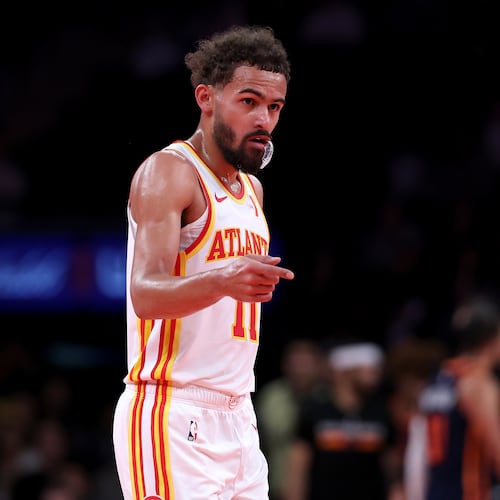MILWAUKEE — The Hawks still have a number of things that they need to figure out, including how to get John Collins more involved offensively.
Collins got off to a hot start this season and averaged 23.5 points over the first two games. However, he has since averaged 10.4 points over the last 11 games.
“It’s new,” Collins told The Atlanta Journal-Constitution on Sunday. “It’s new. You know, just trying to figure it out. It hasn’t been the, you know, the easiest to process.”
The Hawks added guard Dejounte Murray to complement Trae Young in the backcourt. Young is averaging 27.4 points per game, and Murray is averaging 21.7 points per game.
Through the first 13 games, the Hawks have been trying to figure out the new normal and how everyone fits into the scheme of things. But it hasn’t been easy for Collins, who has factored into this team’s offense significantly for the past five years.
“I really feel like I just give a bit (of) everything,” Collins said. “I might post up a little bit, I’ll get a couple rolls, couple lobs, crash glass, run the floor. It’s just what I feel like I do in the flow of the game. So, I feel like that helps me create more, do more. But, I feel like, that’s, or at least, what I’ve been able to do on the Hawks. With us, with the new group, that’s been my calling card and how I’ve been able to make it stick in this league. So making open shots, as well.”
Collins averaged 16.5 points over his first five seasons with the Hawks. But through the team’s first 13 games, he has put up 12.4 points per game, the lowest he has averaged since his rookie season. Last season, Collins averaged 53.6 touches per game. This season, that has dropped to 43.7 touches.
“We have to recognize that, and guards gotta get him the ball,” Hawks coach Nate McMillan said. “Get him involved. I think it’s simple as that. You know, it’s no different than (De’An)dre (Hunter) or some other guy not getting touches, and you know what they’re capable of doing. You know, so you have to out on the floor, our guards must see that, recognize that, whoever – De’Andre, Trae, John (if) they haven’t had a touch, you know, call a play for them.”
Though Collins’ opportunities have been limited, he’s made the most of them. He’s shot 50.4% overall, with 52% of his shots coming less than 10 feet from the basket. When he plays through contact and gets to the line, he’s knocked down 93% of his attempts.
While he hasn’t been the hottest from 3-point range (25%), he knows that he is far more capable of knocking those shots down when he gets into a rhythm.
“I definitely feel like I can shoot the damn ball,” Collins said. “But, you know, sometimes it’s just hard to get a rhythm. I feel like my rhythm might be just a little bit off, but I’m respecting the game and trying to continue to stay in the gym and shoot and not really think too much about it. But, as I said, respect it in a way, right, and put some work into it. Try to keep my body feeling right and try to be positive. As I said, sometimes, I feel like a rhythm is a big part of it. So just trying to keep that.”
The Hawks are 2-0 when Collins scores 20 or more points and 6-5 when he scores fewer. At 8-5, they have the fourth-best record in the Eastern Conference behind the Bucks, the Celtics and the Cavaliers.
Moving forward, the Hawks will look to get the ball moving even more. McMillan has said a couple of times this season that the team looks to average roughly 25 assists per game. Through 13 games, the Hawks have averaged about 24.7, 15th best in the NBA.
McMillan has mentioned that finding the third, fourth or fifth option often creates a higher percentage shot because it keeps defenses off balance.
“It’s open man gets the ball, so that’s something that we say every day. I put on the board every night that we share the ball and then we play in our third and fourth option. That we show patience.”
So, the Hawks will continue to figure out ways to get their top scorers involved when they play the Bucks on Monday and moving forward. Collins understands that it will take time for the team to get on the right page. They’ve talked about it, and they’re looking to grow through it.
“Yeah, there are conversations,” Collins said. “But, you know, not everything can be fixed with just a conv(ersation) sometimes, you know? As I said, it’s growing pains that, like, you can use and are trying to kind of grow through it.”
About the Author
Keep Reading
The Latest
Featured

